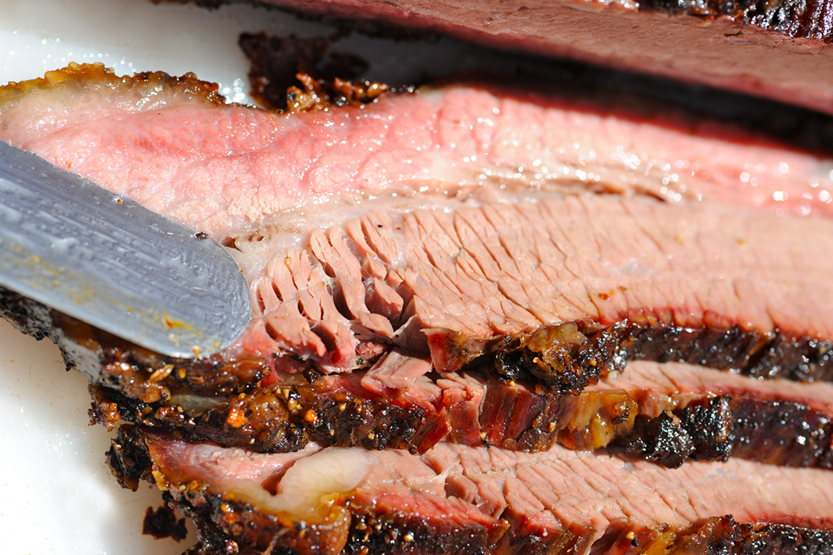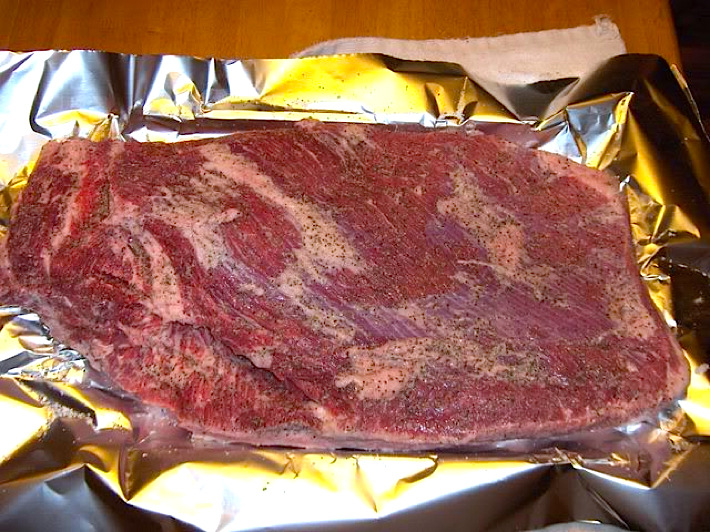While I am down in Austin, Texas at the BlogHer Food conference, I thought it would be fun to share my post on Texas Barbecue from my last time in Austin, during the IACP conference and this luscious Texas-Style Barbecued Brisket. Enjoy!
—————————————————————————————————————
When you go to Austin, Texas, you are inundated with barbecue. Barbecue joints, food trucks, menu items at otherwise non-barbecue restaurants, stands at the airport as you get off the plane, the very air makes you drool with anticipation. The aromas waft around you, evoking memories of summer parties, your fingers dripping with barbecue sauce, coming home with your hair and clothes smelling of the wood smoke. It was like a return to my childhood and one I relished with glee!
I should start by explaining that “Barbecue” has different meanings depending on where in the United States you come from. In California where I live, barbecue is really grilling – anything you want cooked is set on a grill, usually over direct heat. The use of sauce is optional. If you are in the Carolinas, it is usually pork and is mopped with a bright vinegar-based sauce while cooking. Going to a “pig pickin’” is a popular event.
In Memphis it is all about pork ribs and pulled pork cooked with a dry rub and served with a tangy vinegar-tomato sauce. Kansas-City is known for liberal use of a thick, tomato-based sauce and hickory smoke. In St. Louis pork steaks or St. Louis-style ribs are cooked over open fire, mopped with sauce repeatedly while cooking, and then sometimes finished by simmering in a pan of sauce.
And when you are in Texas, it is all about the smoke.
One of the events at the IACP conference in Austin was a roundtable discussion with three of the area’s best pit masters. While not willing to share their exact recipes, they did give us a lot of guidance on the aspects of cooking meats to bring out the best in each piece. We met the men behind Sam’s, Franklin’s, and Gonzales Food Market. Bon Appetit magazine declared Franklin’s the best barbecue in America. Here is a great video on Franklin’s BBQ.
Each man was either a 3rd or 4th generation master in their family, passing down the traditions taught them by their fathers and grandfathers. The sense of family pride permeated the room just as intensely as the aromas of smoked meats coming from the samples we were given. Accustomed to letting their food do the talking for them, it was a bit challenging at first for the moderator to get them to open up, but once they started talking, their convictions in their techniques came through clearly. It was like watching artists talk about their work, sometimes struggling to find the words to express their deeply felt emotions. Each with a natural cautiousness no doubt born from a lifetime of being told to protect their family secrets.

Perfect slices of brisket
While each man cooks many different types and cuts of meats, the focus that day was the pride of Texas, brisket. One mistake many people make is to cut off the fat cap. When it is left intact, it self-bastes the meat, turning a tough dry cut into a moist and tender bite of heaven. Remember that you can always remove excess fat after it has cooked and before serving, but leave it on to flavor and moisten the meat during cooking.
The biggest surprise to me was the simplicity of seasoning. They each agreed that the only thing a good piece of meat needs is salt and pepper. No dry rubs, wet mops, or other flavorings were added. They each season the meat overnight before cooking it. The only other seasoning was the smoke.
The type of wood, its age, and how the fire is managed is paramount to perfectly barbecued meats. When you are working over a live fire, there are many challenges due to the constant variables. It can take years to perfect the technique of tending the fire.
The most common wood used in the Austin area is post oak, a dense, slow burning wood that gives great flavor to anything cooked over it. Others like to use pecan wood for its sweetness, which is similar to hickory. Some add wet wood chips to the fire for even more smoke and some use pecan shells for a subtle flavor enhancement. You want to build your fire on one side of the smoker and wait until you have a deep bed of red coals. The logs should be about half burned before you put the meat on the opposite side. Having air vents above the cool side draws the smoke and heat across the meat, flavoring and gently cooking it, giving it the time it needs to become meltingly tender.
Nearly as important as the technique of slow cooking is resting the meat. The fluids in meat move toward the outside as it cooks and only resting gives them a chance to be reabsorbed. If you pull a steak off the heat and cut into it immediately, your cutting board will be flooded with juices and the meat will be dry. If you let it sit for 15 to 30 minutes, it will be evenly pink all the way through and there will be very few juices on the plate when you slice it.
If you ever watch Top Chef you know that Chef Tom Colicchio is notorious for complaining if a piece of meat hasn’t rested long enough. At Franklin’s, Aaron cooks the brisket slowly all day and then in the evening he wraps each piece in brown butcher paper. It goes back in the smoker to rest overnight. When people arrive in the morning, the meat is ready for them to enjoy.

Look closely and you can see the grain across the top runs differently from the grain on the left side
When you are working with tougher cuts of meat, slicing against the grain is extremely important. If your knife is facing the same direction as the lines on the meat, you are cutting with the grain. If your knife is perpendicular to the lines, it is said to be cutting across the grain. If you cut against the grain, you cut across the tough fibers, tenderizing the meat. If you look at the raw piece of meat above you can see a pattern similar to the grain in a piece of wood. Beef brisket has two connected muscles. Each portion’s grain run in different directions, you need to be very careful when carving it, adjusting the direction of your knife accordingly.
For an unbelievably detailed description of how to cook brisket, including all the details on the grain and how to carve it, take a look at this web page.
With the Fourth of July right around the corner and American’s getting ready for family barbecues and picnics, use these tips and guidelines and today’s recipe for Texas-Style Barbecued Brisket and everyone will consider you the pit master of your neighborhood!
Jane’s Tips and Hints:
Never use lighter fluid with charcoal or everything will have a chemical flavor. Use a charcoal chimney and light it with paper. This is the most efficient and quickest method and the best for your food and the environment.
Gluten-Free Tips:
Make your own barbecue sauce (you can use the recipe below) to control the ingredients, or if you want to use store-bought sauce, make sure you read the labels and beware of gluten-ingredients. The entire line of BBQ Sauce from Stubb’s is gluten-free and you can enjoy with abandon!
Kitchen Skill: How to Smoke the Perfect Brisket
More cooks have trouble turning out a good smoked brisket than almost anything else from the grill. Of course, folks in Texas seem to have no trouble, but that’s because most of them have been smoking brisket since they were able to walk. Fortunately, the secret to success comes to just five basic rules.
1 – BUY THE RIGHT SIZE – Thin cuts of brisket cook very fast, so they don’t have time to absorb the smoky flavor. Buy a brisket that is about 3 inches thick and has a fair amount of fat. Since smoking a brisket is going to take a while, you might as well cook a whole brisket. The leftovers, if you have any, freeze well.
2 – DON’T OVER-SEASON – Lots of television cooking shows and books will push you to season the brisket with all kinds of things. But the guys in Texas who taught me that when they smoke a brisket they rarely use anything other than salt, pepper, and sometimes granulated garlic. They let the wood and smoke do the seasoning.
3 – CHOOSE THE RIGHT WOOD – Mesquite is traditional but very strong tasting. It burns hotter than other common woods like hickory or oak.
4 – GO LOW AND SLOW – A good smoked brisket – meltingly tender and full flavored – is all about patience. You need to maintain a steady, low temperature of 200°F to 250°F in a covered grill or smoker and you need time – at least 6 hours – but it’s worth every minute. (If you run out of time or wood, finish the brisket in the oven. You are the only one who will ever know you did it.) And leave it alone. Don’t open the lid to check on things, you’re just letting out the heat and increasing the cooking time.
5 – WRAP IT UP – If you are not going to be eating the brisket right away, wrap it up in aluminum foil for a few hours to prevent it from drying out. This also helps increase the moisture and many pit masters use this wrap technique as part of their regular practice.


- 1 beef brisket, about 5 lb, fat trimmed to 1/2-inch thick
- Kosher salt and freshly ground black pepper
- 1 tbsp granulated garlic (or garlic powder)
- About 8 cups wood chips, soaked in water for 30 minutes
- Perfect Brisket BBQ Sauce (recipe follows)
- At least 1 hour before you are ready to begin cooking, remove the brisket from the refrigerator. Season it generously all over with salt and pepper. Sprinkle it evenly with the garlic, and then gently rub it into the surface.
- Prepare a smoker, charcoal, or gas grill for smoking over low heat. You want to smoke this brisket very low and very slowly, so the temperature of the grill should be 200°F to 250°F. If using charcoal, bank the lit coals on either side of the grill bed, leaving a strip in the center without heat. Place a drip pan (you can use a disposable aluminum pan) in the center strip and fill the pan with water. Add about 2 cups of the wood chips to the fire just before grilling. If using gas, fill the smoker box with up to 2 cups of the wood chips, then preheat the grill. Turn off 1 or more of the burners to create a cooler zone. Brush and oil the grill grate.
- Place the brisket on the grill over the indirect-heat area and cover the grill. Smoke the meat for about 2 hours, adding additional wood chips every 30 minutes or so and more coals as needed if using charcoal.
- Remove the brisket from the grill and wrap it in aluminum foil. You can put it back in the smoker or on the grill and cook it slowly for another 4 hours (I don’t recommend this if you are using charcoal), or you can place it in a roasting pan in a 250°F. oven for an additional 4 hours. The brisket is ready when it is fork-tender.
- Transfer the brisket to a cutting board and remove the foil. Let rest for 10 to 15 minutes. Thinly slice against the grain, arrange the slices on a platter, and serve at once. Serve the barbecue sauce – reheated or at room temperature – on the side.
- Yield: 10 to 12 servings


- 2 tbsp butter
- 1/4 cup finely chopped yellow onion
- 1 clove garlic, pressed
- 1 cup ketchup
- 1/4 cup firmly packed light brown sugar
- 1/4 cup freshly squeezed lemon juice
- 1 tbsp Worcestershire sauce
- 1 tbsp yellow mustard
- In a small saucepan over medium heat, melt the butter. Add the onions and garlic and cook, stirring, until softened but not colored, about 3 minutes. Stir in the ketchup, sugar, lemon juice, Worcestershire, and mustard and bring to a boil. Reduce the heat to low and simmer, uncovered, until thickened, about 15 to 20 minutes.
- Use right away, or let cool and store in an airtight container in the refrigerator for up to 2 weeks.
- Yield: about 2 cups
Create a New Tradition Today!
Unauthorized use, distribution, and/or duplication of proprietary material on The Heritage Cook without prior approval is prohibited. This includes copying and reprinting content and photographs. If you have any questions or would like permission, I can be contacted via email: theheritagecook (at) comcast (dot) net. Feel free to quote me, just give credit where credit is due, link to the recipe, and please send people to my website, www.theheritagecook.com. Please see the Disclaimers page (https://theheritagecook.com/about/disclaimers/) for additional details.
Thank You!









Georgia @ The Comfort of Cooking
This brisket looks phenomenal, and the sauce so scrumptious! I’d love to try both. Great recipe and tips for this Austin girl, Jane!
Jane Bonacci, The Heritage Cook
Wow, that is a huge complement Georgia, thank you!! With all the amazing “Q” around you, I hope this version can hold its head up, LOL!! According to the pros, knowing how to cut the brisket is half the game! Let me know how it turns out (nervously biting my nails, ha ha).